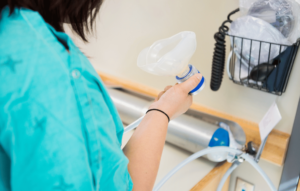Laughing Gas vs Anesthesia: Understanding the Differences for Dental Procedures
Dental procedures can be nerve-wracking for many, especially when it comes to the type of anesthesia used during the treatment process. While many dental clinics offer two types of anesthesia – laughing gas and general anesthesia, some patients may not be familiar with the differences between the two. Laughing gas, also known as nitrous oxide, and general anesthesia, both offer patients a pain-free and calming dental experience, but their effects on the body are quite different. In this blog post, we will explore the differences between laughing gas and general anesthesia for dental procedures.
What is (Nitrous Oxide) Laughing Gas?
Laughing gas is a type of anesthesia that helps patients relax during dental treatment by delivering a mix of nitrogen and oxygen gasses through a mask placed over the patient’s nose. Nitrous oxide has a rapid onset and, within five minutes of administration, begins to take effect, causing feelings of euphoria and relaxation. Laughing gas does not put the patient into a deep sleep but rather helps calm them down during the dental procedure. This means that patients can respond to questions and instructions from the dentist.
What is General Anesthesia?
General anesthesia is an anesthetic that induces unconsciousness and pain management, making the patient unaware and immobile during the dental procedure. It is usually administered through an intravenous (IV) line in the patient’s hand or arm. Patients will experience a deep sleep and will not respond to any questions or instructions during the procedure. General anesthesia is typically used for more intensive or lengthy procedures such as tooth extractions or dental implants.
Which One Should You Choose?
When evaluating a possible anesthesia procedure, check your comfort levels. Are we all anxious about dental procedures? Are you comfortable knowing that there are no problems when the pressure comes out? Your emotions can be a significant factor when choosing an anesthetic type.
People with high levels of dental anxiety, who have difficulty sitting in the dentist’s chair, or who require large amounts of dental work often require sedation to help them remain calm and relaxed. Complex Procedures: Not every wisdom teeth removal procedure is similar. Some might appear simple while some may require complex approaches such as wisdom teeth.
Benefits Of Laughing Gas
- Quick onset and recovery time
- No lingering effects or drowsiness after the procedure
- Can be used for both children and adults
- Provides a calming and relaxed experience
Benefits Of General Anesthesia
- Unconsciousness during the procedure means no anxiety or pain
- Allows for longer, more complex procedures to be completed in one session
- The patient does not remember the procedure afterward
Risks and Side Effects
Both laughing gas and general anesthesia come with a small degree of risk and potential side effects. Laughing gas typically has no lasting side effects and quickly dissipates once the mask is removed. General anesthesia may take longer to wear off and can cause nausea, vomiting, or dizziness after the procedure. It is important to discuss any allergies, medications, and medical conditions with your dentist before undergoing any type of procedure to minimize potential risks.
Recovery Process
Recovery from both types of anesthesia is relatively quick. After a few minutes of breathing in pure oxygen with the mask still on, the effects of laughing gas will wear off, and the patient will be able to leave the office under their power. General anesthesia recovery varies depending on the length and depth of the procedure but typically takes a few hours of monitored rest in a recovery room. The patient will need someone to drive them home and should avoid driving or operating heavy machinery for 24 hours.
In summary, laughing gas and general anesthesia offer patients different experiences during dental procedures. While laughing gas is a suitable option for minor procedures, general anesthesia is best suited for more extensive or complex procedures. Although both types of anesthesia come with some degree of risk and potential side effects, recovery times are generally quick and uneventful. Ultimately, the decision of which type of anesthesia to use is best made in consultation with your dentist to ensure optimal safety and comfort during your dental procedure.
